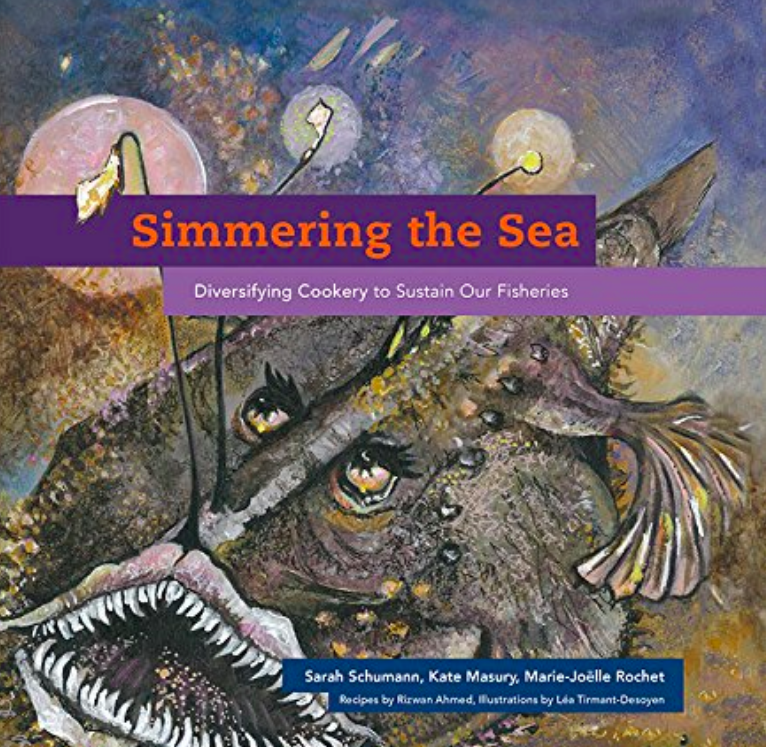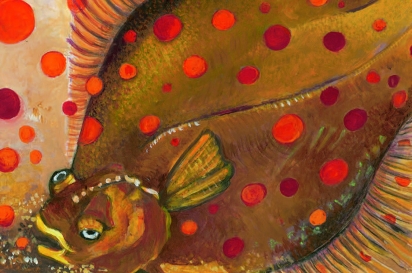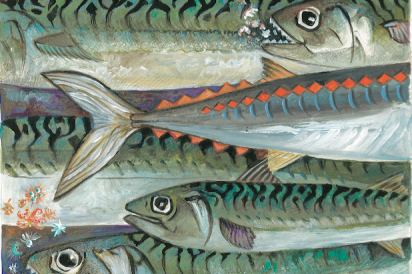An Exerpt from Simmering the Sea: Diversifying Cookery to Sustain Our Fisheries
Excerpted from Simmering the Sea: Diversifying Cookery to Sustain Our Fisheries (University of Rhode Island, 2018). Used with permission. By Sarah Schumann, Kate Masury and Marie-Joëlle Rochet. Recipes by Rizwan Ahmed. Illustrations by Léa Tirmant-Desoyen
KNOWLEDGE IS THE BEST HORS D’OEUVRE…
This book is more than a kitchen manual. It is also a culinary travel guide to the marine ecosystems of the Northwest Atlantic and a “who’s who” of the region’s edible inhabitants. As you work your way through this cookbook, you will become intimately familiar with the creatures who call this part of the world their home. Along the way, you’ll find a new appreciation for the bounty and diversity of the sea.
This cookbook is a tribute to the whole ecosystem. Not just the well- known species that take center stage at the seafood counter, but also the supporting characters who hide in the shadows. It brings these overlooked species into the spotlight. You will find that they are just as delicious, and perhaps even more interesting, than their more famous counterparts.
FLOUNDERS
We are the flounders. There are at least seven kinds of us in East Coast waters: the summer flounder, the winter flounder, the yellowtail flounder, the American dab, the sand dab, the witch flounder, and our hulking big brother, the halibut, who out-eats us all.
All of us begin life with one eye on each side of our heads. But as we transition from the larval to the juvenile stage and sink to the seafloor, one of our eyes makes a gradual migration to the opposite side of the head, where it remains for the rest of our lives. Some of our species have two eyes on the right side; others have two eyes on the left.
We live on the ocean bottom, where we can hide in the sediment and imitate its color to blend in. Sand, silt, and even gravel suit us just fine, but you will never find us among the rocks—they offer neither nourishment nor hiding places for fish of our kind. The sand, on the other hand, is full of little shellfish, worms, and crustaceans to tempt our taste buds. Our ability to lie low in the sediment is a big advantage, but diminished swimming strength is the price we pay for it. When we need to get around, we raise ourselves up off the bottom and let the currents sweep us toward our destination. When the tide or current changes, we sink down again and wait a while, until it turns in our favor again.
Fisheries info: Flounders of many types are caught by otter trawl gear, gillnets, and hook and line. Different species have different seasonal patterns. For the most part, they can all be used interchangeably in a recipe.
Flounder En Papillote
By Rizwan Ahmed
8 flounder fillets
Salt and pepper to taste
8 parsley sprigs, trimmed
¼ carrot, peeled and cut in coins
¼ leek, white part only, cut in coins
¼ zucchini, cut in coins
4 garlic cloves, thinly sliced
½ lemon, thinly sliced
4 tablespoons butter
½ cup white wine
Preheat oven to 450°F. Season fish fillets with salt and pepper. Place a sprig of parsley on each fillet and roll the fillet around the parsley. Mix carrots, leeks, zucchini, and garlic in a bowl and season with salt and pepper. Fold 4 large squares of parchment paper in half and unfold. Place a quarter of the vegetable mixture on each sheet of parchment paper, on one side of the crease. Place 2 rolled fillets atop each pile of vegetable mixture. Place a few lemon slices on each fillet. Top with butter. Fold the other half of the parchment paper over to cover vegetable mixture and fillets. Starting at an end, make overlapping folds along the edges of the paper, pressing and tucking to seal the edges. Before sealing the fourth side, divide wine between each of the 4 packets. Place on baking sheets and roast for 10 to 12 minutes or until parchment puffs. Remove packets and place on 4 separate plates. Have guests cut open from the center of the packets. Be careful of escaping steam.
Many East Coast fish species are lumped together under the name “flounder,” and some go by other names as well, such as sole, plaice, brill, fluke, or dabs. All would be equally suited to this recipe.
Serves 4.
SKATE
Like dogfish, we are boneless “cartilaginous” fishes. As with other members of the shark and ray clan, we take our role as parents very seriously. We practice internal fertilization to make sure that egg meets sperm—we don’t leave that to chance like most “bony” fishes do.
Each baby skate leaves its mother in the comfort of its very own personal protective capsule—the black “mermaids’ purses” that you humans often see washed up on beaches. We spend up to a whole year in one of these pods before emerging to explore the underwater world.
The parts of the ocean we love the best are its gravel and soft bottoms. We like to shimmy underneath the top layer of sediment until we are partially buried. This sediment also provides a convenient meal. Especially when young, we enjoy a varied diet of seafloor organisms: shrimps, hermit crabs, starfish, and snails. But as we grow larger in size, our appetites begin to shift toward swimming fishes like herring, menhaden, hake, and cod.
There are seven species of skate in East Coast waters. The winter skate appears most frequently on dinner menus. However, this species is far less common as a dish than it is in the ocean. A frequent bycatch for many decades, fishermen have only recently started landing it for the market. In contrast, skate is a staple of French cuisine, which makes it a popular option in that country.
MACKEREL
We mackerel live in large, teeming schools. As if sharing a single body, we speed around the sea at up to six miles per hour. We are among the ocean’s great nomads. We winter in the deep waters of the continental shelf from Nova Scotia to the Chesapeake Bay. As soon as the first hint of spring arrives, we head inshore. Our southern tribe celebrates the arrival of warm weather by spawning between the Delaware Bay and Cape Hatteras, while our northern tribe retreats to the Gulf of St. Lawrence to reproduce. Our two tribes mingle in the spring and the fall when both groups fan out along the coasts.
We swim near the surface, sometimes with thousands of feet of water under our bellies. Our mouths stay open as we move, engulfing small planktonic animals, which we filter through combs in our throats. We also sweep up little fish, including juvenile versions of the very fish that prey on us as adults. Sweet revenge, you might say.
Fisheries Info: Mackerel were one of New England’s primary catches at one time, as well as a significant part of the region’s shoreside economy. For whatever reason, they have fallen from grace among American consumers. Nonetheless, a fishery still occurs, mostly between November and April when the schools are inshore. However, much of the catch is shipped abroad.
Mackerel with Tomato Salad
By Rizwan Ahmed
Salad:
1 pint cherry tomatoes, sliced in half lengthwise
1 small red onion, thinly sliced
½ cup pitted olives, preferably Kalamata
3 tablespoons cilantro, finely chopped
1 lemon, juiced
2 tablespoons extra-virgin olive oil
Mix all ingredients together and let marinate in refrigerator for about 30 minutes
Fish:
4 mackerel fillets, skin on
Kosher salt to taste
2 tablespoons extra-virgin olive oil
Season fish with salt. Add oil to a skillet or sauté pan over medium heat. Place fish skin-side down in pan and press down so fish remains flat and achieves a crispy skin. Cook for 3 to 4 minutes and flip. Cook for an additional 1 to 2 minutes. Serve over salad.
You can also prepare this dish with herring, sardines, smelt, or other small fish.
Serves 4.








